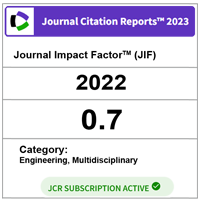Study On Pollution Performance on a Wind Turbine Blade Using OES Technique for Lightning and Switching Impulse Voltage Profiles
DOI:
https://doi.org/10.11113/jt.v64.2103Keywords:
Lightning impulse, transient voltage, wind turbine blade, pollution, salt depositionAbstract
Lightning damage to offshore wind turbine power plants require an immediate attention, due to its severe damage to wind blade causing outage for a long time. The risk of lightning striking the blade is expected to be higher when they are located in a highly polluted and humid zone. Sodium chloride (NaCl) is considered to be among the severe pollutant near sea transported through air and gets deposited on the blade surface thereby increasing the surface conductivity of the material. Lightning can strike any part of the blade other than the receptors and the polluted surface with higher conductivity can allow discharge current to propagate over the surface thus causing severe burning of material and damaging the blade. Hence it is necessary to study the influence of salt deposit on a wind turbine blade injected with standard lightning impulse and switching impulse voltages. Wave profile and polarity has an effect during discharge because of its unique discharge formation process. Preliminary experiments are carried out in laboratory to study the influence of salt deposit on a blade sample by adopting IEC 60507 standards. Experimental results clearly show the extent of surface damage increases with increase in salt concentration. Optical emission based non-intrusive technique is used for an elemental analysis during the discharge process. Optical Emission Spectroscopy (OES) studies clearly show switching impulse voltage of both polarities induce a significant damage to the glass fiber reinforced plastic (GFRP) material.
References
I. Cotton, B. McNiff, T. Soerenson, W. Zischank, P. Christiansen, M. Hoppe-Kippler, S. Ramakers, P. Petterson, E. Muljadi. 2000. International Conf. Lightning Protection (ICLP). 848.
S. F. Madsen, F. M. Larsen, L. B. Hansen, K. Bertelsen. 2004. IEEE Intern. Symp. Electrical Insulation. (ISEI). 484.
T. Naka, N. J. Vasa, S. Yokoyama, A. Wada, S. Arinaga. 2006. Intern. Conf. Lightning Protection (ICLP). 11a2.
N. J. Vasa, T. Naka, S. Yokoyama, A. Wada, A. Asakawa. 2006. Intern. Conf. Lightning Protection (ICLP). 11a1.
S. Sekioka, K. Yamamoto, M. Minowa, S. Yokoyama. 2007. IX Intern. Symp. Lightning Protection.
T. Naka, N. J. Vasa, S. Yokoyama, A. Wada, A. Asakawa, H. Honda, K. Tsutsumi, S. Arinaga. 2005. IEEJ Trans. Power Engineering. 125: 993.
V. A. Rakov, M. A. Uman. 2003. Lightning-Physics and Effects. New York: Cambridge University Press.
K. Miyake, T. Suzuki, K. Shinjou. 1992. IEEE Trans. on Power Delivery. 7: 1450.
M. A. Douar, A. Mekhaldi, M. C. Bouzidi. 2010. IEEE Trans. Dielectrics and Electrical Insulation. 17: 1284.
A. Descoeudres, Ch. Hollenstein, R. Demellayer, G. Walder. 2004. J. Physics D, Applied Physics. 37: 875.
Jobin K. Antony, Nilesh J. Vasa, S. R. Chakravarthy, R. Sarathi. 2010. J. Quantitative Spectroscopy and Radiative Transfer. 111: 2509.
R. Sarathi, G. Nagesh, K. Vasudevan. 2008. World Academy of Science, Engineering and Technology. 15: 177.
V. Sathiesh Kumar, Nilesh J. Vasa, R. Sarathi. 2012. J. Applied Physics A. Doi:10.1007/s00339-012-7219-5.
NIST Handbook of Basic Atomic Spectroscopic Data. http://physics.nist.gov/PhyRefData/Handbook/index.html.
Jin Xu, Zhenqian Lu. 2010. World non grid-connected wind power and energy conference (WNWEC). 1.
Michael G. Danikas, R. Sarathi, P. Ramnalis, S. L. Nalmpantis. 2009. World Academy of Science, Engineering and Technology. 26: 871.
Downloads
Published
Issue
Section
License
Copyright of articles that appear in Jurnal Teknologi belongs exclusively to Penerbit Universiti Teknologi Malaysia (Penerbit UTM Press). This copyright covers the rights to reproduce the article, including reprints, electronic reproductions, or any other reproductions of similar nature.





